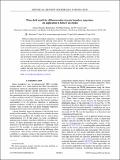Phase-field model for diffusion-induced grain boundary migration: An application to battery electrodes
Author(s)
Renuka Balakrishna, Ananya; Chiang, Yet-Ming; Carter, W Craig
DownloadPublished version (1.969Mb)
Terms of use
Metadata
Show full item recordAbstract
© 2019 American Physical Society. Diffusion-induced grain boundary migration is a phenomenon in which a grain boundary moves in response to the driving forces generated by diffusing solute species. For example, diffusing solute species change the atomic volume in the host material, either by filling a vacancy with a misfitting solute atom or by expanding host lattices through interstitial diffusion. These volume changes are inhomogeneous and are stored as elastic energy in the material that drives grain boundaries. In this paper, we introduce our previously developed Cahn-Hilliard-phase-field-crystal model (CH-PFC) as a computational tool to investigate diffusion-induced grain boundary migration in crystalline materials. This multiscale phase-field model couples the composition field of a diffusing species with the crystallographic texture of a host material. We apply the CH-PFC model to battery electrodes and investigate whether interstitial solute diffusion induces grain growth in FePO4/LiFePO4 electrodes. To this end, we compute grain growth in 60 FePO4 electrodes by conducting two parallel trials: In the first trial, we cycle the electrode and calculate diffusion-induced grain growth. In the second trial, we do not cycle the electrode and calculate curvature-driven grain growth. We find a statistically significant grain growth in the cycled electrodes and negligible grain growth in the noncycled electrodes. Overall, we show that the CH-PFC model not only predicts electrode microstructures as a function of the Li composition, but also predicts the crystallographic features of an electrode during battery operation.
Date issued
2019Department
Massachusetts Institute of Technology. Department of Materials Science and EngineeringJournal
Physical Review Materials
Publisher
American Physical Society (APS)